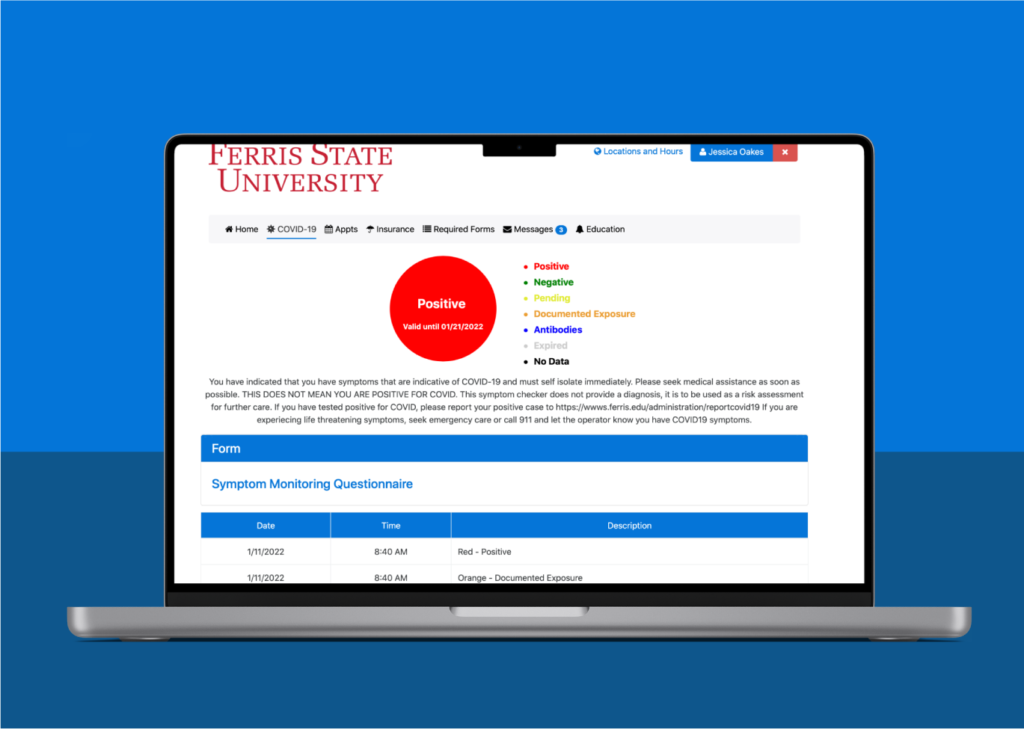
My return to campus for the spring semester was immediately interrupted by Omicron, sending me to quarantine on the first day of syllabus week.
On Monday, Jan. 10, I received the “I Tested Positive for COVID” phone call from a friend and fellow Torch reporter. Being a close contact with this person, I knew the slight tickle in my throat could not be attributed to a common cold.
I hastily grabbed my backpack and suitcase, still partially packed from winter break, and headed off campus to isolate myself indefinitely. At 9:45 the following morning, I reported the situation to Ferris’ Healthy Dog Portal.
As my symptom checker turned red, bi*********@****is.edu promptly sent an automated email to my inbox. The message explained that I should follow all self-isolation protocols from the CDC’s website, and that “someone from the university will reach out to [me] within one business day to discuss next steps.”
It took over 48 hours for any further instruction to reach my inbox, long after I finished my own contact tracing.
“Due to the high volume of COVID-19 cases, I am emailing anyone who has tested positive with isolation and contact tracing instructions,” Ferris COVID Case Manager Shawn Dahlstrom wrote.
This message, titled Isolation Resources, came in four main parts. The attached documents included information from the CDC, District Health Department #10, and the university. They explained the basics of self-isolation, how to care for someone with COVID-19, and how to politely notify my professors of my illness, respectively.
Immediately, I noticed some contradictions in my instruction. My symptom checker indicated that it would remain COVID positive for the next ten days, coinciding with DHD 10’s recommended isolation time.
“People with COVID-19 who have stayed home can stop home isolation when the following three conditions are met: you have not had a fever for at least 72 hours, and your other symptoms have improved, and it has been at least ten days since your symptoms first started,” the DHD 10 document read.
However, in the same email, I learned that Birkam only expected me to quarantine for five days, assuming I remained fever-free for 24 hours. After this time, I could leave isolation if I avoided spaces where masking is not possible for an additional five days.
Dahlstrom’s contact information was included in this lengthy email, as I was welcome to reach out if I had any additional questions. Near the end of my isolation, I called the phone number provided and sent a message via Outlook. Neither of which resulted in any response.
Due to a lingering cough and sore throat, I decided to isolate for the full ten days. Thankfully, I was able to stay off-campus, as a Miller Hall quarantine dorm was not offered to me.
Miller Hall room 109 was offered to Dylan Rider, the Torch sports reporter that initially exposed me to COVID.
“Hello Dylan, you are receiving this email because you were identified as needing to isolate due to COVID-19. In order to best serve your needs, we will be temporarily placing you in Miller Hall room 109,” Emily Maloy of Ferris State Housing wrote.
Maloy explained that students staying in Miller Hall are provided with food three times a day, and should bring a five-day supply of bedding, towels, clothing, entertainment, and study materials.
Unfortunately, Rider was no longer on campus once this message reached his inbox. It was sent to him nearly 24 hours after he received his positive test results and instruction to immediately self-isolate away from his dorm.
This experience showed that students who report their illness independently, without a scheduled test from the university, are not offered the same quarantine resources as those who do receive a test through Ferris.
During quarantine, I felt a disparity between my COVID case and that of others. DHD 10 recommended one thing, while Ferris recommended another. My friend was offered an untimely spot in the quarantine dorms, while I was offered none. There was no clear path to recovery.
From the duration and location of quarantine to the varying attendance policies set by my professors, there was no consistent answer. My encounter with COVID reflected the lack of one unified pandemic response.
